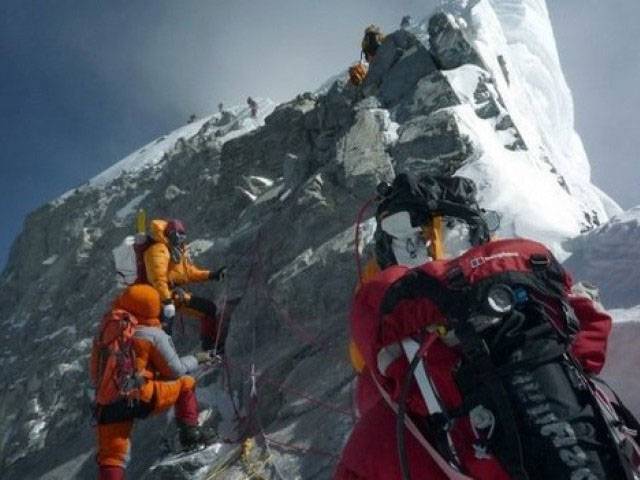KATHMANDU - At least 12 Nepalese guides preparing routes up Mount Everest for commercial climbers were killed Friday by an avalanche in the most deadly mountaineering accident ever on the world's highest peak, officials and rescuers say.
The men were among a large party of Sherpas carrying tents, food and ropes who headed out in bright sunshine in an early morning expedition ahead of the main climbing season starting later this month.
Four of them are still missing, tourism officials said, while one rescuer at the scene said he expected the death toll to rise by at least three after other bodies were spotted but not retrieved.
The avalanche occurred at around 6:45 am (0100 GMT) at an altitude of about 5,800 metres in an area nicknamed the "popcorn field", due to boulders of ice that lie on the route leading into the treacherous Khumbu icefall.
"We have retrieved 12 bodies from the snow," Nepal tourism ministry official Dipendra Paudel told AFP in Kathmandu.
He said that deteriorating weather conditions had forced rescuers to suspend searches for the missing climbers until Saturday morning.
"We do not want to risk another accident," he said. Assisted by rescue helicopters, at least seven people were plucked alive from the ice and snow on Friday with the injured sent by helicopter to a hospital in the capital.
Kathmandu-based expert Elizabeth Hawley, considered the world's leading authority on Himalayan climbing, said the avalanche was the most deadly single accident in the history of mountaineering on the peak Everest.
The previous worst accident occurred in 1996 when eight people were killed during a rogue storm while attempting to summit the mountain, which was first conquered in 1953 by Sir Edmund Hillary and Tenzing Norgay.
The 1996 tragedy was immortalised in the best-selling book "Into Thin Air" written by US mountaineering journalist Jon Krakauer and is the subject of a Hollywood film under production.
"This is the absolutely the worst disaster on Everest, no question," Hawley told AFP.
Kathmandu-based climbing company Himalayan Climbing Guides Nepal confirmed that two of their guides were among the dead and four were missing.
"When our guides left base camp, there was no snowfall, the weather was just fantastic," operations manager Bhim Paudel told AFP.
Dozens of guides from other companies crossed the icefall safely before the avalanche struck, Paudel said.
"We expected to follow them, we had no warning at all," he said.
Every summer, hundreds of climbers from around the world attempt to scale peaks in the Himalayas when weather conditions are at their best.
In the past, some accidents have been blamed on overcrowding or on ill-prepared commercial climbers taking unnecessary risks in a bid to reach the summit before returning home.
Friday's accident underscores the huge risks borne even by experienced Sherpas , who carry tents, bring food supplies, repair ladders and fix ropes to help foreign climbers who pay tens of thousands of dollars to summit the peak.
A trekking workers' union told AFP its vice-president, Dorje Khatri, who had summited Everest at least eight times, was among the missing.
"Seven of our members were victims of the accident... we have been told that Dorje Khatri's body has not been found," said Suman Parajuli, central general secretary of the Union of Trekking Travels Rafting Workers Nepal.
Two years ago, Karsang Namgyal Sherpa, an experienced climber who scaled the peak successfully several times, died on the mountain, apparently due to altitude sickness.
More than 300 people have died on Everest since the first summit in 1953.
Nepal's worst-ever climbing disaster happened in 1995 when a huge avalanche struck the camp of a Japanese trekking group near Mount Everest, killing 42 people including 13 Japanese.
The impoverished Himalayan country is home to eight of the world's 14 peaks over 8,000 metres.
Nepal's government has issued permits to 734 people, including 400 guides, to climb Everest this summer.
In a bid to address concerns of overcrowding on the "roof of the world", the government earlier announced plans to double the number of climbing ropes on congested ice walls near the summit of Everest to reduce congestion and risks for climbers.
Authorities have also stationed soldiers and police at Everest base camp starting this month so climbers can approach officers in case of any trouble following a brawl between commercial climbers and Nepalese guides last year.
Tuesday, April 16, 2024
12 guides die in worst-ever Everest accident

Caption: 12 guides die in worst-ever Everest accident
8:31 PM | April 16, 2024
PTI founder not in favour of any deal, says Gohar
8:53 PM | April 16, 2024
CM Maryam reviews medical facilities at THQ hospital Murree
8:34 PM | April 16, 2024
Military leadership resolves to eliminate menace of terrorism with public support
8:34 PM | April 16, 2024
Pakistan, Saudi Arabia call for immediate ceasefire in Gaza
8:32 PM | April 16, 2024
PTI to hold political gatherings across country
8:31 PM | April 16, 2024
Political Reconciliation
April 16, 2024
Pricing Pressures
April 16, 2024
Western Hypocrisy
April 16, 2024
Policing Reforms
April 15, 2024
Storm Safety
April 15, 2024
Democratic harmony
April 16, 2024
Digital dilemma
April 16, 2024
Classroom crisis
April 16, 2024
Bridging gaps
April 16, 2024
Suicide awareness
April 15, 2024
ePaper - Nawaiwaqt
Advertisement
Nawaiwaqt Group | Copyright © 2024





